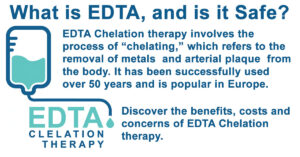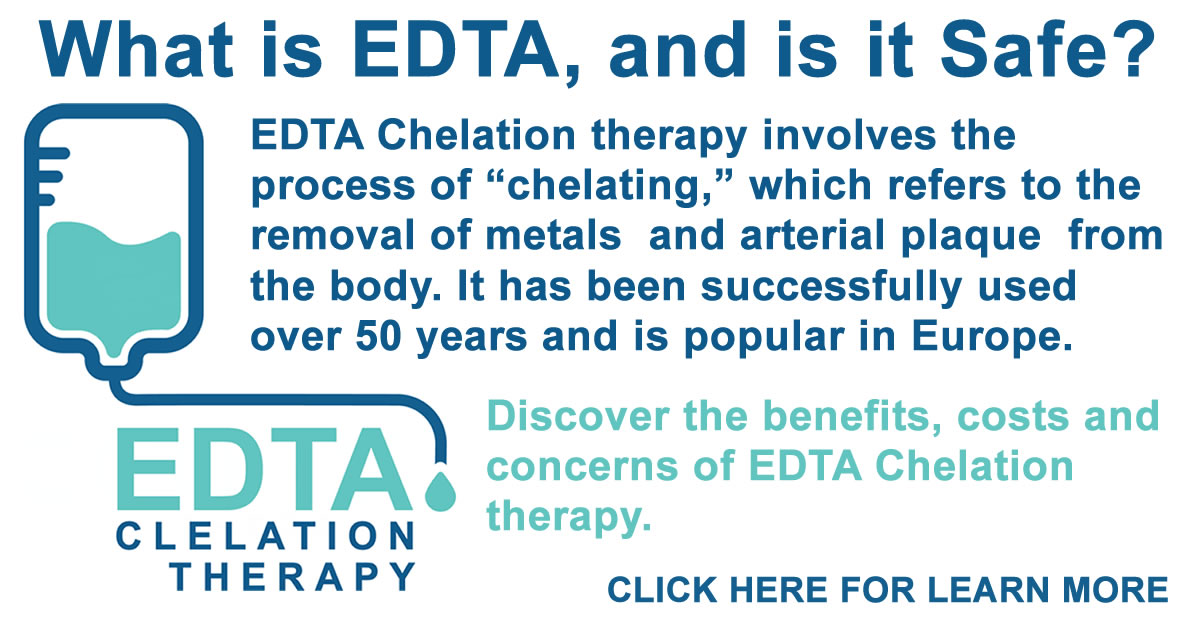What is EDTA?
 Chemical Structure: The chemical structure of EDTA is a hexadentate ligand containing four carboxylic acid groups and two amines arranged in a linear fashion. The basic formula is C10H16N2O8, and it is synthesized from ethylenediamine, formaldehyde, and sodium cyanide[iv].
Chemical Structure: The chemical structure of EDTA is a hexadentate ligand containing four carboxylic acid groups and two amines arranged in a linear fashion. The basic formula is C10H16N2O8, and it is synthesized from ethylenediamine, formaldehyde, and sodium cyanide[iv].
Chelating Properties: EDTA’s most significant characteristic is its ability to form stable complexes with metal ions by surrounding and capturing them. EDTA will bind to pretty much any metal ion across the periodic table[v]. This process is known as chelation, and it is used in various applications, such as water treatment, food preservation, and medical treatments.
Applications of EDTA: EDTA is utilized for water treatment to remove metal ions by with them[vi], preventing them from reacting with other chemicals or causing undesired effects. This is crucial in preventing the formation of scale and corrosion in pipes and industrial equipment.
Food Industry: EDTA is used as a preservative in the food industry to prevent the oxidation of fats and oils, examples that it is used in include Grain-Based Products like breads, mayo, Beverages, including Alcohol, used as a flavor enhancer, canned seafood, canned vegetables to preserve flavor and color[vii]. By chelating metal ions that catalyze oxidation reactions, EDTA helps extend the shelf life of certain food products.
Medical and Pharmaceutical: EDTA is an effective anticoagulant. It is employed as an anticoagulant in blood collection tubes. It binds to calcium ions, preventing blood clotting and allowing for accurate testing and analysis[viii].
Chelation Therapy: In medicine, EDTA is used in chelation therapy to remove heavy metals from the body. It is administered intravenously to treat heavy metal poisoning[ix]. While accepted in conventional medicine for heavy metal poisoning, it has found a place in alternative health practices for benefits beyond metal detoxification. Proponents claim that chelation therapy can improve cardiovascular health[x] by removing excess calcium from arteries, potentially reducing arterial plaque. However, it is not without risks if not properly administered, and can lead to side effects, including hypocalcemia (low calcium levels), allergic reactions, and kidney damage, abdominal cramps, nausea, vomiting, diarrhea, headache, low blood pressure, skin problems, and fever[xi].
Make no mistake, many people support it use and benefits. EDTA has been used for more than 50 years[xii] however it must be overseen by a well-trained professional. Further it is expensive. The costs range anywhere to $200 to $600 dollars per session, and multiple sessions are usually required. Not to mention the fact that it is not easy to find a health care professional if you do not live in a large suburban area. You may have to travel long distance to find someone properly trained.
EDTA as a Detergent: Water Softening: EDTA is used as a liquid detergent because it binds to metal ions like calcium and magnesium found in hard water. This is why it is used in water softer. It prevents mineral deposits on fabrics during the washing process[xiii].
Cosmetics: EDTA is added to cosmetic and personal care products as a stabilizer, helping to maintain the product’s quality by preventing the degradation of ingredients due to metal ions[xiv].
Textile Industry: In the textile industry, EDTA is used to enhance the dyeing process by forming complexes with metal ions that could interfere with the dyeing process[xv].
Environmental Considerations: While EDTA has many beneficial applications, its environmental impact is a subject of concern. The chelated metal-EDTA complexes can persist in the environment, leading to potential contamination of water systems. Research is ongoing to develop more environmentally friendly alternatives and to find ways to minimize the environmental impact of EDTA[xvi].
In conclusion, ethylenediaminetetraacetic acid (EDTA) is a versatile compound with widespread applications in various industries. Its ability to chelate metal ions makes it valuable in processes ranging from water treatment to medical treatments.
Citations
[i] Fulgenzi A, Ferrero ME. EDTA Chelation Therapy for the Treatment of Neurotoxicity. Int J Mol Sci. 2019 Feb 26;20(5):1019. doi: 10.3390/ijms20051019. PMID: 30813622; PMCID: PMC6429616.
[ii] Lamas GA, Ergui I. Chelation therapy to treat atherosclerosis, particularly in diabetes: is it time to reconsider? Expert Rev Cardiovasc Ther. 2016 Aug;14(8):927-38. doi: 10.1080/14779072.2016.1180977. Epub 2016 May 5. PMID: 27149141; PMCID: PMC5105603.
[iii] https://edta.net/home/
[iv] http://www.chemspider.com/Chemical-Structure.5826.html
[v] https://jila.colorado.edu/news-events/articles/how-bind-metals-and-water-new-study-edta
[vi] Zhang, Kai & Dai, Zhengwei & Zhang, Wanglong & Gao, Qiang & Dai, Yu & Xia, Fan & Zhang, Xiaojin. (2021). EDTA-based adsorbents for the removal of metal ions in wastewater. Coordination Chemistry Reviews. 434. 213809. 10.1016/j.ccr.2021.213809.
[vii] https://www.irochelating.com/news/foods-that-contain-edta.html
[viii] Banfi G, Salvagno GL, Lippi G. The role of ethylenediamine tetraacetic acid (EDTA) as in vitro anticoagulant for diagnostic purposes. Clin Chem Lab Med. 2007;45(5):565-76. doi: 10.1515/CCLM.2007.110. PMID: 17484616.
[ix] Ferrero ME. Rationale for the Successful Management of EDTA Chelation Therapy in Human Burden by Toxic Metals. Biomed Res Int. 2016;2016:8274504. doi: 10.1155/2016/8274504. Epub 2016 Nov 8. PMID: 27896275; PMCID: PMC5118545.
[x] https://smithhamish88.medium.com/edta-chelation-therapy-oral-dosage-a-promising-treatment-for-atherosclerosis-b1ff6a70e24
[xi] https://www.rxlist.com/supplements/edta.htm
[xii] Lamas GA, Goertz C, Boineau R, Mark DB, Rozema T, Nahin RL, Lindblad L, Lewis EF, Drisko J, Lee KL; TACT Investigators. Effect of disodium EDTA chelation regimen on cardiovascular events in patients with previous myocardial infarction: the TACT randomized trial. JAMA. 2013 Mar 27;309(12):1241-50. doi: 10.1001/jama.2013.2107. PMID: 23532240; PMCID: PMC4066975.
[xiii] https://stppgroup.com/unveiling-the-secrets-of-sparkling-laundry-the-hidden-marvels-of-anti-redeposition-agents-in-your-detergent-arsenal/
[xiv] https://www.origins.com/ingredient-gallery/edta
[xv] Das, D., Bakshi, S., & Bhattacharya, P. (2016). Dyeing of EDTA-Modified Cotton With Reactive Dyes. Clothing and Textiles Research Journal, 34(3), 196-206. https://doi.org/10.1177/0887302X16652998
[xvi] https://researchcommons.waikato.ac.nz/handle/10289/3284

